Anna’s Hummingbird (Calypte anna) Male photos by Larry Jordan
Almost every day I enjoy the company of a male Anna’s Hummingbird (Calypte anna). He perches on a metal fence I put up to protect a bed of sunflowers we planted outside my home office window. Click on photos for full sized images.
He is protecting a hummingbird feeder that hangs from the eves about 12 feet away.
You will notice in this series of images that the colors of the feathers on his head change as he turns his head.
This is due to a complex feather structure that I explained with photos in a previous post. This fellow is in total shade so his colors are not as vibrant as they would be in full sun.
But, as I was saying, he is guarding one of the hummingbird feeders, strategically placed around the house. So, to let you know what an excellent source Birds of North America Online (BoNAO) is, I will give you some information on the Anna’s Hummingbird’s food habits from their website.
Hovering bird extends tongue into flower corolla to extract nectar. Insects are usually taken in the air, sometimes several successively. May also “hawk,” leaving perch to capture insect, then returning to perch. Investigates spider webs for small captured insects, and visits water and damp areas. Sometimes gleans tiny insects from leaves and presumably takes sap and insects from holes made in oaks, willows, and other trees1.
If you have hummingbird feeders you have probably witnessed (usually) male birds protecting a feeder and chasing off intruders. This is what BoNAO has on this behavior.
Males defending feeding territories may fill their crops only 10–33% of capacity at a time, thus keeping their weight at a minimum and reducing the energetic cost of flight. Individuals without their own defended source of food must intrude into territories and are likely to be chased; the intruders consume as much nectar (to crop capacity) as the opportunity provides. Crops are filled late in the day in preparation for roosting; the crop contents serve as a “supplemental energy storage depot” during the night. Although a high level of early-morning consumption might be expected after a night of fasting, studies found a fairly even feeding rate at feeders throughout the day, until peaking 1–2 hours before sunset1.
I filmed this video of my early morning companion, scanning the sky for intruders, chasing them off and finding a little time to preen. Enjoy!
For more great bird photos, check out Wild Bird Wednesday and The Bird D’pot. Two excellent memes for bird photographers and enthusiasts!
References: 1Birds of North America Online

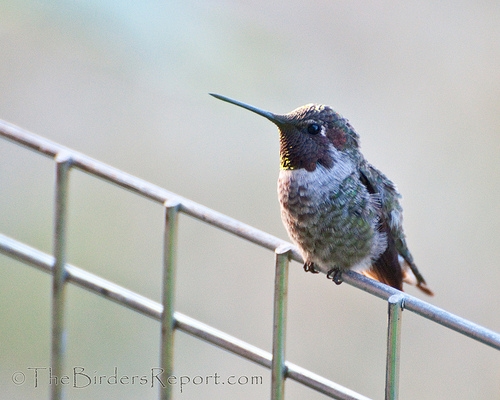
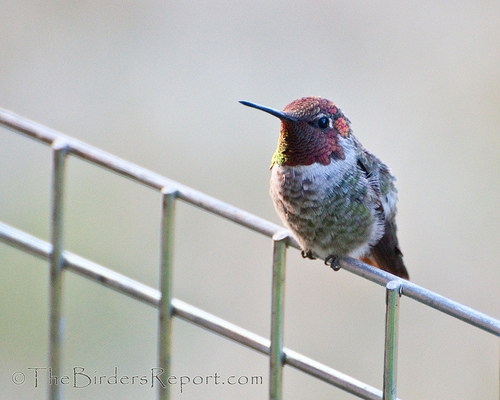
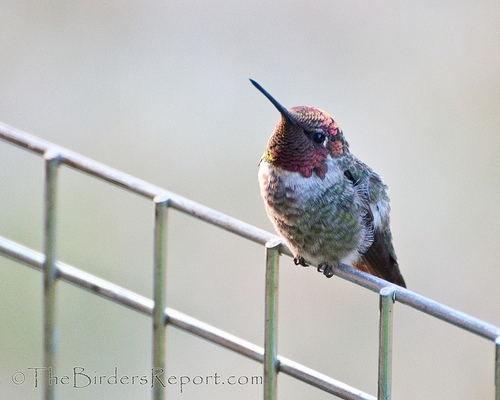
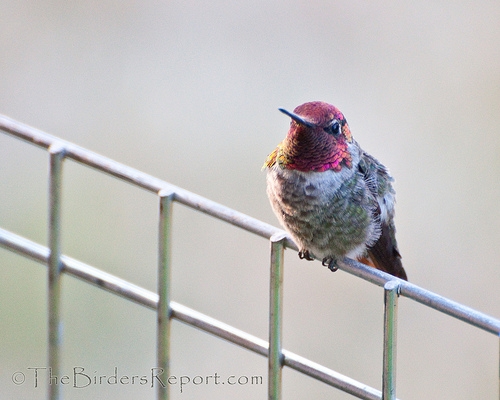
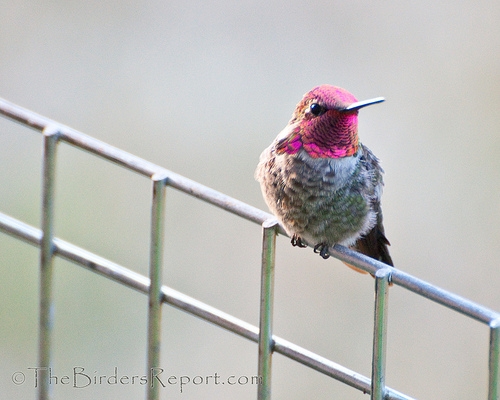








Comments on this entry are closed.
Beautiful Anna’s Hummingbird Larry, love the video too.
he’s really beautiful. love the fuschia color.
Lovely. Do visit http://nopincode.com : some bird love happening there as well. Would love to be in touch with like-minded souls 🙂
Spectacular hummers Larry. I love watching them. Yes, they are VERY protective of ‘their’ feeders.
I loved reading that you have a Caracara spotted in California!!! That’s awesome.
Incredibly beautiful pictures you show.
Thank you for looking into my blog.
Wishing you a good day 🙂
Hanne Bente
Enjoyed the video Larry. That bird is just so alert in guarding his spot and turning in and out of the light shows off his iridescenct head markings so well.
Wonderful pics & video of the male Anna! I have many Annas in my So Cal garden, as well. They are such good garden friends. Interesting about the feeding habits of a male defending his space vs. the intruders. I’m off to read your previous post about the head feathers changing colors~
Beautiful captures!! Boom & Gary of the Vermilon River, Canada.
Those changes in color as the light changes are amazing. That long slender bill looks like an awesome weapon to be used on other hummers.
What a beautiful little bird! Your photos and video are excellent.
Larry, I love your cute Anna’s Hummer. They are beautiful birds.
Thanks, again, for posting views of a favorite bird of mine Larry….I just wanted to stop by and send along my appreciation for visiting me at my personal blog…
I also do the Bird D’Pot Meme on Sundays.
The whole idea that you get these birds most mornings feels me with green eyed jealousy!
Great set of pictures.
Stewart M
Terrific video, Larry. It must be stressful being a male Anna’s Hummingbird! Interesting how he shoots out his long tongue. We only get Ruby-throated Hummingbirds here but they show the same sudden abrupt head turning – it must be characteristic for hummingbirds.
So cute! A great WBW post!
Very nice photos! Good to see them up so close. We always seem to have on dominant male who wants to run all the others off, too.
I have 5 feeders for ruby-throats around the yard and there is always one male guarding..but interesting info..I saw a ruby-throat “U” display against a hummingbird clearwing moth who was nearby…they are amazing little birds…Michelle
what an amazing video!! i caught one quick glimpse of his tounge. gorgeous pink!!!!
Stunning birds and really fantastic shots. Great to see.
The pictures (and video) are all amazing — it’s such a beautiful bird. And I always appreciate what you teach me about birds (teaching so painlessly and beautifully)!
Our male hummingbird does the same thing here,he is driving off his offspring I`m sure!Love the hummingbird photos,more colorful than ours,phyllis
Awe Larry, DELIGHTFUL!!! Oh to see one of these in person!!! I love the throat colour. My husby, pup-cub and I will be in California next month, driving out from Kentucky. Will visit daughter in LA and then off to Yosemite and Sequoia, before heading to Reno to visit family, via Lake Tahoe. Maybe I will see some new species to photograph along the way;’)~
Beautiful vidéo 😉
Céline & Philippe
Wonderful photos of this beautiful bird! Their coulors are fantastic, I really would love to see one in real 🙂
A lovely little fellow and very interesting facts. I wish you a great weekend!
What a gorgeous little bird, Larry!! The video is great and your images are wonderful. I’d love to have a feeder in the yard to attract more birds. I love the colour change of the hummingbird, and I’ve learned a lot about this bird I’ve never seen in real life. Thanks for sharing
What a fantastic video – watching the head colors change as it turns. AWESOME. We don’t get Anna’s much here 🙁
http://yellowbreastedchat.com/
Nice video, Larry. That little guy is certainly vigilant. I miss the hummers we had at our previous home in New Mexico. The Rufous hummers really took over after they arrived in early July.
Hi Larry!
Soo sweet little bird and your photos are fantastic! Amazing how the colour on the head changes.
I may add that we don’t have this little fellow up in the cold north in Europe and that’s a pity.
Thanks for your comment in my blog and also to you, for having translation on your blog! 🙂
Greetings from Pia in Sweden
how gorgeous it is. And great shots to show it. I wish we had them in Sweden.
We have two feeders and a wren house with a perch in front. Our hummingbird will sit on that perch for hours on end guarding his two feeders. It’s really funny, but I wonder if it’s okay for his health to depend of sugar water and to not go out and get the nutrients he needs from plants?